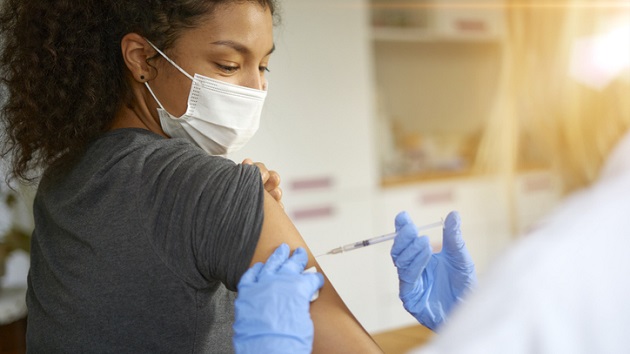Scientists are working on combo flu and COVID-19 shot, but don’t expect one this fall
Andriy Onufriyenko/Getty Images
(NEW YORK) — With more scientists predicting COVID-19 boosters will be needed each year, some are now working on combining those with the annual flu vaccine. The idea, experts say, is a single injection given each fall that protects against seasonal flu and COVID-19.
Pharmaceutical companies Moderna and Novavax have already announced plans to work on a combo shot, but don’t expect them to be available this upcoming flu season. Instead, Moderna’s CEO saying a combo shot could be ready by 2023.
Although studies indicate COVID-19 vaccine efficacy fades over time, experts say it’s not a foregone conclusion that every American will need an annual COVID-19 booster. Dr. Anthony Fauci, the nation’s top infectious disease expert, said this week that as of right now, most Americans don’t need a fourth dose (beyond the existing booster shot), but scientists are constantly evaluating the situation.
“I think we first have to assess the long-term need for annual COVID vaccines,” says Dr. Anna Durbin, director of Center for Immunization Research at Johns Hopkins University.
However, “if there is a continued need for COVID vaccines, then combining that with influenza would make sense,” Durbin said.
There are a few technical challenges to creating a combination vaccine. One is that different scientific approaches have been used for the two types of vaccines.
“Right now, the influenza vaccine is a different platform,” said Durbin. The most widely used flu vaccines in the US contain ‘inactivated’ (killed) or attenuated (weakened) virus to trigger an immune response in the body. This differs from mRNA (or messenger RNA) vaccines which teach the body’s cells how to make proteins that trigger immune responses. The result is that they currently have to be given in separate shots.
While two of the three authorized COVID vaccines are based on mRNA technology, previous influenza vaccines have not utilized this technology. But now, Moderna and Pfizer are working on an mRNA flu vaccine.
In addition to differences in technology, an extra challenge is that the most common influenza vaccine in the U.S. is quadrivalent, meaning it is designed to protect against four different flu viruses.
“This means the combined influenza/COVID vaccine would also likely need to be quadrivalent or at least trivalent. That makes the vaccine more complicated,” says Durbin.
Similarly, the rise of new COVID variants may introduce challenges to vaccine development.
This past September, Novavax enrolled people in a Phase 1/2 study to evaluate the safety, tolerability and immune response of a combination vaccine using Novavax’ seasonal influenza and COVID-19 vaccines. Unlike Pfizer and Moderna’s vaccines which use mRNA, these vaccines use protein subunit technology, which introduces a fragment of the virus into the body that is recognized by the immune system and triggers a response. These have each previously demonstrated strong results as standalone vaccines in Phase 3 clinical trials.
Moderna has also announced that it is developing a single dose vaccine that combines a booster against COVID-19 and a booster against flu, called mRNA-1073. In preclinical studies, Moderna has observed that its seasonal flu and COVID-19 booster vaccines can be combined into one dose that produces an immune response to both viruses.
Moderna CEO Stéphane Bancel predicted this combo shot could be available in 2023 — not in time for this upcoming flu season, but potentially the following year.
“I think it makes a lot of sense to try to develop these vaccines, but it may take a bit of time,” Durbin said.
Aiya Aboubakr is an internal medicine resident at New York Presbyterian-Weill Cornell Medical Center, and a contributor to the ABC News Medical Unit.
Copyright © 2022, ABC Audio. All rights reserved.

